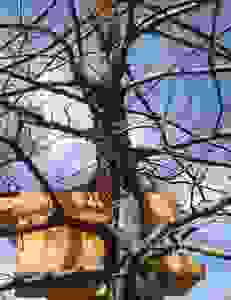Bee Swarms

Your basic swarm of honeybees .....
When talking about bee swarms, the first thing we’d like to get across is that a bee swarm is a natural phenomenon and a beautiful miracle of nature. Please don’t be taken in by Hollywood and the mainstream press planting pictures of mothers and children running down the street being mercilessly chased by clouds of angry bees ala Alfred Hitchcock’s Birds movie only with smaller assailants. Not that that can’t happen if Timmy uses a Hornet’s nest he found as a football. But a bee swarm is very different and happens for a different reason.

Why Do Bees Swarm?
Honeybees are unique in that when a hive’s Queen feels she is running out of space in her hive she will make a decision to split the hive and start a new one. Sometimes a hive will swarm because they feel the urge to and the spring season is so strong they just feel compelled to.
Once she has made this decision, the Queen will send of bee “scouts” to find a new suitable location. She will also create in her hive what we call “Queen Cells”. She will start maybe a half dozen of these cells. The peanut shaped cell in the photo is a Queen cell. The purpose of these cells is to create a new Queen within the hive. Eventually these cells will hatch out a new Queen. Once the first new Queen is hatched she will generally kill the other cells because the hive can only have one Queen. The cell repetition exists to ensure that at least one new Queen will hatch.
Once the hive’s original Queen has laid her new Queen Cells she knows that original hive will continue to grow and flourish under the new management. She then feels confident to take 5000-10,000 of her bees and start a new hive in a location found by one of the scouts she sent out.

What does a Swarm look like?
What a swarm looks like depends on when you’re seeing it. The swarm starts when the Queen leaves the hive. As this is one of the only times a Queen will exit a hive after her initial fertilization it is a big thing as far as the hive goes. Once she has exited, she will usually land a short distance away from the original hive to get her bearings and to let group around her the bees that will be accompanying her. If you look at a swarm right when it starts it can be VERY intimidating though not dangerous. It will look a lot like a tornado of bees flying all around almost in a circle ranging from about 6 to 20 feet in height. It can be scary to walk through. But, within 5-15 minutes, this “tornado” of bees finds the Queen where she has situated herself and they will all merge on her. This second stage of the swarm looks like a big ball of bees. You might see them hanging on a tree branch, fence post or gutter. Believe it or not, the bees within this ball are very docile. They are not so much to be feared but admired and respected. They are totally focused on the Queen and relocating her quickly and safely. You can see in the picture that I’m right up next to a swarm from one of our hives without any protective gear or worries. The bees will remain like this for maybe an hour and then fly off in a group to wherever they’ve decided to relocate.

How To Catch a Basic Swarm
The only real way for us to capture a swarm is to catch it when it is in that ball. What we’ll do is place a hive box beneath the swarm and gently sweep the bees into the box. Most often, we'll try to cut the branch the bulk of the swarm is on and (very!) gently drop/place it into the box. As long as the Queen is swept into the box, all the bees will follow her inside within an hour. Once we’re sure that the Queen is in the box, we’ll reduce the size of the entrance to ensure she can’t leave. It is not uncommon to have a swarm try to leave the new hive box if you don’t. Sometimes, no matter how nice a new home you provide them, they’ll try to insist on setting up in that hollow tree down the road. Hence trapping the Queen. From there we’ll relocate the box to another area and, hey presto, we’ve got a new beehive.

Waiting for everyone to find their way inside .....

Up a Tree
The other way to trap a swarm is by being able to find their new hive location, grabbing the Queen and putting her into a new hive box allowing her bees to follow. Please keep in mind that all this can only happen if the “ball of bees” or new hive is accessible by us. If it is 80 feet up a tree there is understandably a problem accessing it.

Closer Look
A closer look at that. It was about 25 feet up a very flimsy small forest of bamboo.
Luckily for us, bamboo bends almost double safely and it was just a matter of doing that and capturing the swarm without letting go of the stalks of bamboo which would have snapped upright and flung the whole swarm of bees Goddess knows how far. A comical though until it lands on a family's picnic table....

And happily finding their way inside to their Queen

And a look from the front of the box. That was a large swarm!

Just remember. Swarms aren't things to be feared. They are a miracle of nature. Enjoy them
People tend to fear things less once they understand them
Copyright © 2021 Eco Honeybees - All Rights Reserved.
ecohoneybees@cox.net